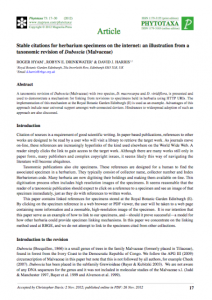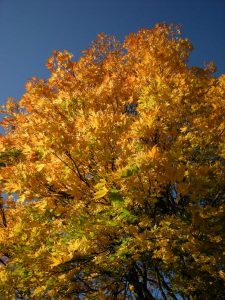 After a few delays with the proofs going backwards and forwards to the publishers we have finally had our paper published in Phytotaxa. I am excited about this as I hope it is the beginning of our leading by example in the biodiversity informatics realm. Previously I have been involved in some large projects that have involved many institutions reaching agreement on how something should be done before it is implemented. Sometimes this is the best way forward but there are also cases where it is appropriate for a forward looking institution to take a lead and “just do it”. This is an example of the latter.
After a few delays with the proofs going backwards and forwards to the publishers we have finally had our paper published in Phytotaxa. I am excited about this as I hope it is the beginning of our leading by example in the biodiversity informatics realm. Previously I have been involved in some large projects that have involved many institutions reaching agreement on how something should be done before it is implemented. Sometimes this is the best way forward but there are also cases where it is appropriate for a forward looking institution to take a lead and “just do it”. This is an example of the latter.
What we describe in the paper is that herbarium specimens within our collections should be referenced on the internet using stable HTTP URIs (a.k.a. URLs). An example of the URIs we use for our specimens is http://data.rbge.org.uk/herb/E00421509. You may recognize the final part of the URI as being the barcode from one of our herbarium specimens. The paper is open access so you can just click the link to read the full copy.
Hyam, R.D., Drinkwater, R.E. & Harris, D.J. Stable citations for herbarium specimens on the internet: an illustration from a taxonomic revision of Duboscia (Malvaceae) Phytotaxa 73: 17–30 (2012).
Abstract:
A taxonomic revision of Duboscia (Malvaceae) with two species, D. macrocarpa and D. viridiflora, is presented and used to demonstrate a mechanism for linking from revisions to specimens held in herbaria using HTTP URIs. The implementation of this mechanism
at the Royal Botanic Garden Edinburgh (E) is used as an example. Advantages of this approach include near universal support amongst web-connected devices. Hindrances to widespread adoption of such an approach are also discussed.
Not mentioned in the paper is the fact that our living accessions also have unique URIs on the internet. An example is http://data.rbge.org.uk/living/19031037 which links to an accession of Acer platanoides L. ‘Crispum’ on the Rhododendron walk in Edinburgh.


Bob Morris
Nice work.
In the case of the living specimens, I suppose that the accession numbers predate the computing era and are in principle subject to errors of repetition. I presume that you easily can tell that there are not two records with the same accession number in your database. But how do you know that there aren’t duplicated accession numbers back in time, and that the digitization process simply dropped the first when it encountered the second, or otherwise confused the two miscreants?
–Bob
Roger Hyam
Hi Bob,
We had a year zero for living material and issued them all with an id quite a few years ago now. I’m not aware of one number with two accessions existing and if it has then it has been sorted usually by one being in use and the other not. If push came to shove we could have a disambiguation record like they have in Wikipedia. i.e. duplicates don’t occur but if they did they would be easy to fix.
BTW – we currently only offer HTTP URIs for ‘accessions’ although internally we also have qualified numbers for plants within an accession. Imagine a packet of seed comes into the garden. It gets an accession number. The seed is sown and results in a number of plants of that accession and they get ids which are the accession number plus a string of letters. The same thing applies through any propogation process. This is not ideal. I’d like to see entirely different numbers for the plants but having slightly human readable identifiers helps the horticulturalists. I hope to issue HTTP URIs for the plants at some point in the future.
All the best,
Roger